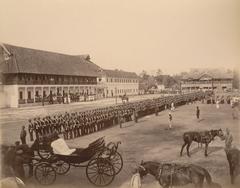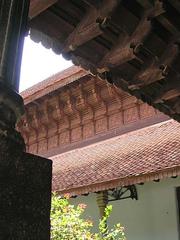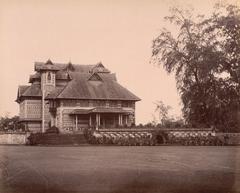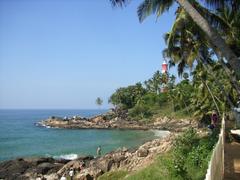
Comprehensive Guide to Visiting Thiruvananthapuram, Thiruvananthapuram District, India
Date: 13/08/2024
A Captivating Introduction to Thiruvananthapuram
Welcome to Thiruvananthapuram, the heart of Kerala, where history and modernity dance in a mesmerizing tango. Picture this: ancient temples whispering secrets of yore, the aroma of spicy curries wafting through bustling markets, and serene beaches beckoning you to unwind. Did you know that Thiruvananthapuram is home to the Sree Padmanabhaswamy Temple, one of the wealthiest temples globally, with treasures still hidden in its vaults? This captivating city, once known as Trivandrum during British colonial rule, has a legacy that spans millennia, from the ancient Ays dynasty to the princely state of Travancore and beyond (Wikipedia).
Thiruvananthapuram is not just a destination; it’s an experience. Imagine walking through the Napier Museum, where artifacts from Kerala’s colonial past come alive, or exploring the Veli Tourist Village, where tranquility meets adventure. This city is a living tapestry of cultural and religious essence, with landmarks like the Sri Padmanabhaswamy Temple and the Kanakakunnu Palace narrating tales of divine and royal grandeur (Medium).
Ready to dive into the local vibe? Savor the authentic Kerala-style fish curry, stroll through the bustling Chalai Bazaar, or embark on a mini-quest to find the oldest shop in town. Whether you’re a history buff, a nature lover, or a culinary enthusiast, Thiruvananthapuram has something to offer. And guess what? With the Audiala app, your journey through Thiruvananthapuram will be nothing short of magical. Our app provides expert insights and unlocks the city’s hidden stories, making it the perfect companion for your travels. So, pack your bags, grab your camera, and let’s explore Thiruvananthapuram like never before!
Table of Contents
- Historical Background
- Major Attractions
- Sree Padmanabhaswamy Temple
- Kovalam Beach
- Napier Museum
- Attukal Bhagavathy Temple
- Vellayani Lake
- Kuthira Malika (Puthen Malika) Palace
- Shangumugham Beach
- Kanakakunnu Palace
- Zoological Gardens
- Science and Technology Museum and Planetarium
- Veli Tourist Village
- Neyyar Wildlife Sanctuary
- Ponmudi Hill Station
- Vizhinjam Rock Cut Cave Temple
- Peppara Wildlife Sanctuary
- Visitor Tips
Historical Background of Thiruvananthapuram
An Enchanting Journey Through Time
Step into Thiruvananthapuram, where every stone whispers stories of yore, and every corner holds a secret waiting to be unveiled. The capital of Kerala is not just a city; it’s an experience that spans millennia, weaving together ancient legacies, colonial tales, and modern marvels. Let’s embark on this captivating journey through time.
Ancient and Medieval Tapestry
Imagine a bustling port where ships from King Solomon’s fleet once anchored around 1036 BCE. This is Thiruvananthapuram, initially ruled by the Ays, who were affiliated with the Chera dynasty. Renowned for their trading prowess, the Ays set the stage for a vibrant historical narrative (Wikipedia).
Fast forward to the 12th century, when the Kingdom of Venad conquered the region. This marked the beginning of a new political era, laying the groundwork for the future princely state of Travancore (Wikipedia).
The Rise of Travancore Royalty
The 18th century ushered in a transformative era under Marthanda Varma, a ruler with grand visions. In 1729, he founded the princely state of Travancore, with Thiruvananthapuram becoming its capital in 1795. Picture the grand celebrations as the city witnessed the fall of the mighty Zamorin of Kozhikode in the Battle of Purakkad in 1755 (Wikipedia).
Colonial Echoes: The British Influence
Under British colonial rule, Thiruvananthapuram was known as Trivandrum. The colonial legacy is etched in its architecture, with stately buildings standing as silent witnesses to a bygone era. It wasn’t until 1991 that the city reclaimed its original name, Thiruvananthapuram (Wikipedia).
Post-Independence Transformation
With India’s independence in 1947, Thiruvananthapuram became the capital of the Travancore-Cochin state, and later, the capital of Kerala in 1956. Today, it’s a hub of academic excellence and research, home to institutions like the University of Kerala and APJ Abdul Kalam Technological University (Wikipedia).
Cultural and Religious Essence
The city’s name, derived from “thiru-anantha-puram” or “The City of Lord Ananta,” is a tribute to the presiding deity of the Sri Padmanabhaswamy Temple. This temple, a fusion of Kerala and Dravidian architectural styles, is one of the 108 Divya Desams, sacred abodes of Vishnu in the Sri Vaishnava tradition (Wikipedia).
Hidden Gems and Local Secrets
Beyond the famous landmarks, Thiruvananthapuram offers hidden treasures like the serene Veli Tourist Village, where you can enjoy a peaceful boat ride, or the bustling Chalai Bazaar, a sensory overload of colors, sounds, and smells.
Key Historical Landmarks
Sree Padmanabhaswamy Temple
This temple is not just a place of worship but a treasure trove of history and legend. Its secret vaults, rumored to hold untold riches, add an air of mystery to its architectural grandeur (Medium).
Napier Museum and Zoo
Step into the 19th century at the Napier Museum, housing artifacts, bronze idols, and relics that narrate Kerala’s colonial past. Adjacent to it, the Trivandrum Zoo offers a walk through India’s wildlife heritage (Medium).
Kanakakunnu Palace
Built during the reign of Sree Moolam Thirunal, the Kanakakunnu Palace blends traditional Kerala and colonial styles. Today, it’s a vibrant cultural hub hosting events and exhibitions throughout the year (Medium).
Modern Marvels
Thiruvananthapuram is a leading IT hub, contributing 55% of Kerala’s software exports as of 2016. Its educational landscape is equally impressive, with institutions like the University of Kerala and its various affiliates (Wikipedia).
Insider Tips for Visitors
- Best Time to Visit: October to March is when the weather is just right.
- Local Cuisine: Dive into dishes like appam, puttu, and Kerala-style fish curry.
- Getting Around: The city is well-connected via road, rail, and air. Trivandrum International Airport makes it accessible for global travelers (TravelTriangle).
- Cultural Etiquette: Dress modestly and respect local traditions, especially at religious sites.
Interactive Challenges
Why not embark on a mini-quest? Find the oldest shop in Chalai Bazaar or try to count the steps leading up to the Sree Padmanabhaswamy Temple.
Conclusion
Thiruvananthapuram is a living tapestry of history, culture, and modernity. Its allure lies not just in its monuments but in the stories, secrets, and experiences it offers. Ready to explore? Download the Audiala app for an immersive audio guide that will unlock the city’s hidden stories and secrets. Trust us, this journey through Thiruvananthapuram will be one for the books!
Major Attractions in Thiruvananthapuram
Sree Padmanabhaswamy Temple
Dedicated to Lord Vishnu, the Sree Padmanabhaswamy Temple is a must-visit. Imagine intricate Dravidian architecture and a seven-story gopuram reflecting in a sacred tank. The deity here, Lord Padmanabha, lounges on the cosmic serpent Anantha (source).
Kovalam Beach
Kovalam Beach offers golden sands, coconut groves swaying in the breeze, and three crescent-shaped beaches just begging for a leisurely stroll. It’s like a tropical paradise just 16 kilometers from the city (source).
Napier Museum
The Napier Museum is a feast for the eyes with its blend of Indian, Chinese, and Mughal architecture. Inside, it’s like stepping into a time capsule with ancient sculptures, bronze idols, and traditional ornaments (source).
Attukal Bhagavathy Temple
The Attukal Bhagavathy Temple hosts the world-famous Attukal Pongala, a festival that draws millions of women cooking up a storm with their Pongala offerings (source).
Vellayani Lake
Vellayani Lake is the largest freshwater lake in Thiruvananthapuram, perfect for boating, fishing, or just chilling by the water (source).
Kuthira Malika (Puthen Malika) Palace
Built by Maharaja Swathi Thirunal Balarama Varma, Kuthira Malika Palace dazzles with traditional Kerala architecture and 122 horse carvings (source).
Shangumugham Beach
For a serene city escape, head to Shangumugham Beach. White sands, a giant mermaid statue, and stunning sunsets – what’s not to love (source)?
Kanakakunnu Palace
Feel like royalty at Kanakakunnu Palace, right in the city’s heart. This historic site, with its lush gardens and beautiful architecture, hosts cultural events galore (source).
Zoological Gardens
Animal lovers, the Thiruvananthapuram Zoological Gardens beckon! One of India’s oldest zoos, it’s a green haven with tigers, lions, elephants, and exotic birds (source).
Science and Technology Museum and Planetarium
The Science and Technology Museum and Planetarium is a blast. Interactive exhibits explain scientific principles in fun ways, while the planetarium offers cosmic journeys through astronomy and space (source).
Veli Tourist Village
Picnic time? Veli Tourist Village is your spot. Located where Veli Lake meets the Arabian Sea, it’s perfect for boating, pedal boating, or horse riding (source).
Neyyar Wildlife Sanctuary
If you’re wild at heart, the Neyyar Wildlife Sanctuary is a must-visit. About 32 kilometers from the city, it’s a wildlife haven with elephants, tigers, and deer (source).
Ponmudi Hill Station
Escape to Ponmudi Hill Station, about 55 kilometers away. Rolling hills, tea plantations, and lush greenery make it a scenic retreat (source).
Vizhinjam Rock Cut Cave Temple
History and spirituality blend at the Vizhinjam Rock Cut Cave Temple near Kovalam. Dating back to the 8th century, this temple features rock-cut sculptures of Lord Shiva and Parvati (source).
Peppara Wildlife Sanctuary
Peppara Wildlife Sanctuary is a biodiversity hotspot with elephants, leopards, and various birds (source).
Visitor Tips for Thiruvananthapuram, Thiruvananthapuram District, India
Best Time to Visit
The optimal time to visit Thiruvananthapuram is during the winter months from October to February. During this period, the weather is pleasantly cool and dry, with temperatures ranging from 18°C to 32°C, making it ideal for outdoor exploration and sightseeing. This season also coincides with several vibrant festivals such as Onam and the Trivandrum International Film Festival, offering a rich cultural experience (Travelsetu).
Accommodation
Given that the winter months are peak tourist season, it is advisable to book accommodations well in advance. Thiruvananthapuram offers a range of lodging options, from budget hotels to luxury resorts. Notable areas to consider for staying include near Kovalam Beach and Sree Padmanabhaswamy Temple, which provide easy access to major attractions (Holidify).
Transportation
Thiruvananthapuram is well-connected by air, rail, and road. The Trivandrum International Airport serves both domestic and international flights. The city’s railway station, Thiruvananthapuram Central, is a major hub in the Southern Railway network. For local travel, auto-rickshaws, taxis, and buses are readily available. Renting a car or hiring a private taxi can offer more flexibility for exploring the city and its surroundings.
Key Attractions
Padmanabhaswamy Temple
One of the most iconic landmarks, the Padmanabhaswamy Temple, is a must-visit. This historic temple is renowned for its intricate Dravidian architecture and is considered one of the wealthiest temples in the world. Note that only Hindus are allowed entry, and a strict dress code is enforced (Travelsetu).
Kovalam Beach
Kovalam Beach is famous for its crescent-shaped coastline and offers a variety of water sports and leisure activities. The beach is divided into three parts: Lighthouse Beach, Hawah Beach, and Samudra Beach, each offering unique experiences. Lighthouse Beach is particularly popular for its panoramic views from the Vizhinjam Lighthouse (Travelsetu).
Napier Museum and Kuthira Malika Palace
For history and art enthusiasts, the Napier Museum and Kuthira Malika Palace are essential stops. The Napier Museum houses a vast collection of archaeological and historical artifacts, while Kuthira Malika Palace, also known as Puthen Malika Palace, showcases traditional Kerala architecture and royal memorabilia (Holidify).
Cultural Festivals
Onam Festival
Onam is one of Kerala’s most significant festivals, celebrated with great enthusiasm in Thiruvananthapuram. The festival includes elaborate feasts, floral decorations, traditional music and dance performances, and the famous snake boat races. The grand procession, Athachamayam, features decorated elephants and cultural floats (India.com).
Attukal Pongala
Attukal Pongala is a unique women-centric festival held at the Attukal Bhagavathy Temple. Recognized by the Guinness World Records for the largest gathering of women, this festival involves cooking a sweet delicacy called Pongala on temporary hearths set up on the streets (India.com).
Outdoor Activities
Neyyar Wildlife Sanctuary
Located about 30 km from the city, Neyyar Wildlife Sanctuary is a haven for nature lovers and wildlife enthusiasts. The sanctuary offers opportunities for trekking, boating, and wildlife safaris. It is home to a variety of flora and fauna, including elephants, tigers, and a wide range of bird species (Holidify).
Ponmudi Hill Station
Ponmudi Hill Station, situated around 55 km from Thiruvananthapuram, is an excellent destination for trekking and enjoying the scenic beauty of the Western Ghats. The hill station is known for its lush green landscapes, tea plantations, and pleasant climate (Travelsetu).
Dining and Cuisine
Thiruvananthapuram offers a diverse culinary scene, with traditional Kerala cuisine being a highlight. Must-try dishes include Kerala Sadya, a traditional vegetarian feast served on a banana leaf, and seafood delicacies like Karimeen Pollichathu (pearl spot fish). Psst… For the best masala dosa, head to a tiny, unassuming eatery called ‘Aunty’s Kitchen’ tucked away behind the main market. Trust us, it’s worth the hunt!
Safety and Health
While Thiruvananthapuram is generally safe for tourists, it is advisable to take standard precautions. Keep your belongings secure, especially in crowded areas. During the monsoon season (June to September), be cautious of heavy rainfall and potential flooding. It is also recommended to carry mosquito repellent and stay hydrated, especially during the hotter months (Holidify).
Shopping
For those interested in shopping, Thiruvananthapuram offers a variety of options. Local markets and shops sell traditional Kerala handicrafts, spices, and textiles. Popular shopping areas include Chalai Bazaar and Connemara Market. For a more modern shopping experience, visit the malls and shopping complexes in the city.
Language and Communication
Malayalam is the official language of Kerala, but English is widely understood and spoken, especially in tourist areas. Learning a few basic phrases in Malayalam can enhance your travel experience and help in better interaction with locals. Try this: ‘Ente peru (your name) aanu’ means ‘My name is (your name).’ Now you’re practically a local!
Emergency Contacts
In case of emergencies, here are some important contact numbers:
- Police: 100
- Ambulance: 102
- Fire Brigade: 101
- Tourist Helpline: 1800-425-4747
Having these numbers handy can ensure a safe and hassle-free visit to Thiruvananthapuram.
By following these tips, visitors can make the most of their trip to Thiruvananthapuram, enjoying its rich cultural heritage, natural beauty, and warm hospitality. Ready to uncover Thiruvananthapuram’s hidden gems? Download Audiala, your ultimate tour guide app, and let the city’s secrets unfold through expert insights and captivating audio guides. Adventure awaits!
Call to Action
As your journey through Thiruvananthapuram comes to a close, you’ll leave with more than just souvenirs; you’ll carry memories of a city that seamlessly blends the old and the new. From the ancient echoes of the Sree Padmanabhaswamy Temple to the vibrant cultural festivals like Onam and Attukal Pongala, Thiruvananthapuram offers a rich tapestry of experiences that cater to every traveler’s whim (India.com).
Whether you’ve marveled at the intricate architecture of the Kuthira Malika Palace, soaked in the sun at Kovalam Beach, or explored the lush landscapes of Neyyar Wildlife Sanctuary, each moment in Thiruvananthapuram is a story waiting to be told. And let’s not forget the delightful culinary adventures that await you; from savoring Kerala Sadya on a banana leaf to indulging in the freshest seafood, your taste buds are in for a treat.
But the allure of Thiruvananthapuram doesn’t end here. The city’s charm lies in its ability to surprise and enchant, offering hidden gems like the serene Veli Tourist Village and the bustling Chalai Bazaar. And with the Audiala app, your exploration doesn’t stop when the tour ends. Audiala offers beautifully crafted audio guides that delve deep into the city’s secrets and stories, providing an immersive experience that makes Thiruvananthapuram come alive in your ears and heart.
So, are you ready to uncover the secrets of Thiruvananthapuram? Download Audiala today and let the city’s stories unfold. Trust us, this journey through Thiruvananthapuram will be one for the books!
References
- Wikipedia (2023). Thiruvananthapuram. Retrieved from Wikipedia
- Wikipedia (2023). Padmanabhaswamy Temple. Retrieved from Wikipedia
- Medium (2021). Exploring the Treasures of Kerala’s Capital City. Retrieved from Medium
- TravelTriangle (2023). Places to Visit in Trivandrum. Retrieved from TravelTriangle
- Travelsetu (2023). Best Time to Visit Trivandrum. Retrieved from Travelsetu
- Holidify (2023). Best Time to Visit Trivandrum. Retrieved from Holidify
- India.com (2021). Discover the 6 Best Cultural Festivals in Thiruvananthapuram. Retrieved from India.com
- Safarmentor (2023). Thiruvananthapuram Tourism. Retrieved from Safarmentor
- Kerala Tourism (2023). Destinations in Trivandrum. Retrieved from KeralaTourism








